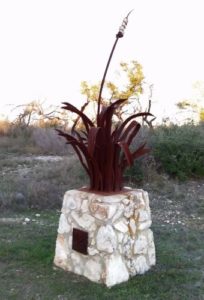Despite it being out of the way, I’ve been to Stone Oak Park twice. The first time was July of 2015 and it was just amazingly hot. It seemed like a nice park, though, so Alex and I returned in November of 2015 so that we could finish the rest of the main walking path.
It turns out that we saw most of the exciting stuff on that first trip.
Stone Oak Park has the usual things, bicycle trails, a playground, a picnic pavilion, portable restroom facilities, and so forth. The park also has a 2.7-mile walking trail marked by public artworks. I am trying to find the names of the artworks, but haven’t had much luck so far. Perhaps this will be my excuse to return.

Stone Oak Park is also home to two caves, known as Bear Cave and Cub Cave. Bear Cave got its name from the bones of a black bear that were found inside. Cub Cave got its name because whoever named the caves wanted to stick with the “bear” theme and Cub Cave is smaller than Bear Cave. Bear Cave is blocked off to keep people from climbing or falling in. As of my last visit, Cub Cave was still open.
Stone Oak Park was founded for one very practical reason — it is in a vulnerable area of the state known as the Edwards Aquifer Recharge Zone. In particular, the caves along the recharge zone are important for cleaning the water as it enters the aquifer. The aquifer is where San Antonio and its surrounding area gets its drinking water. The water drains into the aquifer in a region from just outside Loop 1604, stretching up past the western boundaries of New Braunfels and San Marcos, and way off to the west to around Brackettville (which is between Uvalde and the border with Mexico). In the process of preserving this land, the city has preserved two of the most important caves for keeping our water clean.
